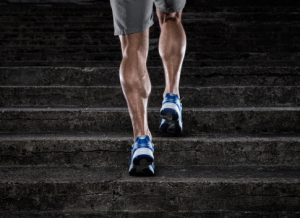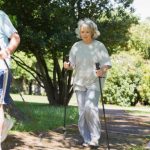 Boosting walking speed and intensity could improve mental health in aging. A recent study found that strong legs are associated with a strong mind, and to achieve strong legs faster, more intense walking can be utilized.
Boosting walking speed and intensity could improve mental health in aging. A recent study found that strong legs are associated with a strong mind, and to achieve strong legs faster, more intense walking can be utilized.
The findings come from a 10-year British study, which revealed that strong legs are linked with a strong mind. It included 324 healthy female twins between the ages of 43 and 73 from the UK. Thinking, learning and memory were tested at baseline and at the end of the study.
Advertisement
The researchers found that leg strength was a greater predictor of brain health compared to any other lifestyle factors. The twin with the strongest legs maintained their mental capabilities though the 10 years and experienced fewer age-related brain changes compared to the twin with weaker legs.
Lead author, Dr. Claire Steves, said, “Everyone wants to know how best to keep their brain fit as they age. Identical twins are a useful comparison, as they share many factors, such as genetics and early life, which we can’t change in adulthood. It’s compelling to see such differences in cognition [thinking] and brain structure in identical twins, who had different leg power 10 years before. It suggests that simple lifestyle changes to boost our physical activity may help to keep us both mentally and physically healthy.”
Previous research linked physical activity and brain function in older adults, and in animal models it has been revealed that exercise releases hormones that encourage nerve cell growth.
The findings were published in Gerontology.
Mental health affecting leg muscle strength loss by inactivity
 Just like strong legs can be an indicator of good mental health, poor mental health can also negatively affect leg muscle strength by contributing to inactivity. In order for our legs to stay strong we must use them, but for someone with a mental disorder, the desire to be physically active becomes greatly diminished, thus contributing to leg muscle-strength loss.
Just like strong legs can be an indicator of good mental health, poor mental health can also negatively affect leg muscle strength by contributing to inactivity. In order for our legs to stay strong we must use them, but for someone with a mental disorder, the desire to be physically active becomes greatly diminished, thus contributing to leg muscle-strength loss.
Another study showed that it only takes two weeks of inactivity for muscle strength to become lost. Andreas Vigelso from the University of Copenhagen said, “Our experiments reveal that inactivity affects the muscular strength in young and older men equally. Having had one leg immobilized for two weeks, young people lose up to a third of their muscular strength, while older people lose approx. one fourth. A young man who is immobilized for two weeks loses muscular strength in his leg equivalent to ageing by 40 or 50 years.”
Aging is a large factor in muscle-mass loss, but researchers also found that just two weeks without activity could promote muscle loss in young adults similar to that in inactive seniors. Furthermore, the younger generation actually lost more muscle than the seniors.
Martin Gram from the Center for Healthy Aging and the Department of Biomedical Sciences added, “The more muscle mass you have, the more you’ll lose. Which means that if you’re fit and become injured, you’ll most likely lose more muscle mass than someone who is unfit, over the same period of time. But even though older people lose less muscle mass and their level of fitness is reduced slightly less than in young people, the loss of muscle mass is presumably more critical for older people, because it is likely to have a greater impact on their general health and quality of life.”
Influence of exercise on muscle capacity in older people, especially women
Women, in particular, have been found to experience many benefits of muscle capacity through exercise. In one study, researchers found positive effects of resistance training in older women by improving body composition, muscle strength, muscle power and physical function. Obtaining further understanding of how muscle strength improves physical function could be used as a way to prevent disability in older women.
Aging can contribute to muscle loss, which can increase the risk of injury and limit a person’s ability to perform daily tasks. By preserving muscle strength, not only can it prevent injury, but it can provide seniors with more independence as they can continue to perform the tasks they always did without being bound to a chair or bed.
Leg strengthening exercises for seniors
 If you’re a senior and are looking to boost brain function as well as maintain muscle strength, it’s good to start with the legs; they are one of the largest muscles and they keep us moving. Below are some easy, at-home leg exercises you can practice daily to improve leg muscle strength.
If you’re a senior and are looking to boost brain function as well as maintain muscle strength, it’s good to start with the legs; they are one of the largest muscles and they keep us moving. Below are some easy, at-home leg exercises you can practice daily to improve leg muscle strength.
Ankle circles: This can be done sitting or standing – if standing you may have to hold on to a wall or a chair for support. Simply lift your foot off the ground and begin rotating your ankle clockwise and counter clockwise.
March on the spot: If walking long distances tires you out, you may wish to begin with simply marching on the spot.
Knee extensions: Sit on a chair and lift your leg up from the knee. Continue to raise your leg and put it back down to strengthen your quad muscles.
Calf raises: While standing, come up on your toes so your calves are flexed, then come back down so your whole foot is on the floor. Keep raising and lowering yourself to strengthen your calves.
Sit to stand: This is an easy exercise and is incredibly useful. Simply sit on a chair and then stand up. To really strengthen your muscles, work your way to standing without using your hands to push off the chair. Once standing sit back down and repeat.
Leg raises: Lie flat on your back and lift one leg at a time (or both legs, depending on your core strength) straight up in the air and bring it back down. This exercise also strengthens your abdomen.
Partial squat: A regular squat would have you drop pretty low to the ground, but a partial squat lowers you slightly, as if you were about to sit down but then you come back up again.
Tips to keep your legs healthy in old age
Legs get us from point A to point B so you’ll want to keep them strong, even in your older age, to ensure you can continue to get around. Here are some tips to help keep your legs strong.
- Don’t cross your legs when sitting as it reduces circulation
- Exercise regularly
- Take essential vitamins for muscles
- Keep legs elevated and parallel to the ground to improve circulation
- Avoid high heels
- Take warm showers to dilate blood vessels and improve circulation
- Avoid staying in one position for long periods of time
- Don’t smoke
- Eat a healthy diet
- Maintain a healthy body weight
Following these tips can ensure that your legs will stay strong for many more years to come.
Related Reading:
Falls and fractures in elderly linked with muscle loss, sarcopenia
Recent research has revealed that older adults who suffer from age-related muscle loss are at higher risk of experiencing falls and fractures. The researchers, from the University of Southampton, looked into sarcopenia – muscle loss and function – and found that those with the highest reported muscle loss had the most falls and prevalence of fractures within a year. Continue reading…
Advertisement
Causes of skeletal muscle weakness and atrophy due to aging
Researchers have discovered a protein – ATF4 – which contributes to skeletal muscle weakness and atrophy during aging. The study was conducted by the University of Iowa and published in the Journal of Biological Chemistry. Continue reading…
Sources:
http://consumer.healthday.com/senior-citizen-information-31/misc-aging-news-10/strong-legs-linked-to-strong-brain-as-you-age
http://healthsciences.ku.dk/news/news2015/inactivity-reduces-peoples-muscle-strength
http://www.sciencedirect.com/science/article
http://eldergym.com/leg-exercises
http://www.partnersinseniorcare.com/resources/CareConnectorFiles/TenTipsforHealthyLegs
